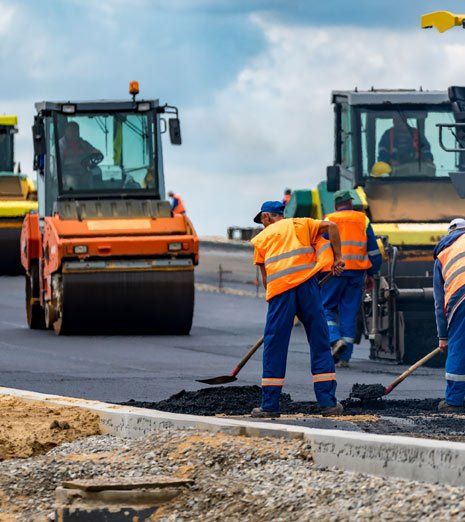Street and Highway Pavements
Street and Highway Pavement Consultants in New York, the Burroughs, Nassau, and Suffolk Counties, Connecticut, and New Jersey - Kagaoan Engineering

Pavement Consulting
Providing soil testing, documentation for suitable construction projects and monitoring road surfaces are just a few of the things geotechnical engineers do for highway builds. These roads experience a tremendous amount of weight and traffic, putting stress on the roadway and the soil beneath. Making sure a site is suitable for a highway is necessary when cities expand into new areas. Existing structures need routine checks or constant tracking to ensure the surface stays safe for drivers, groundwater sources, and residents living near the location.
Kagaoan Engineering drafts blueprints, tests soils, inspects and surveys the land, provides monitoring, boring, pinning, and many other services for these structures. Our team works primarily in the Tri-State area, focusing on New York, New Jersey, and Connecticut towns. Our team uses decades of knowledge and experience to provide tailored services for our clients. From drafting to permits and laser measurements, our professionals guarantee exceptional service and quality.
To find out more about highway pavement services or other foundation or soil tests, please contact our specialists at Kagaoan Engineering at 516-208-1533, or Contact us
for free consultation.
An Overview of Streets and Highway Pavements
These road structures are heavy layers of material that sit on the ground to help commuters, semi-trucks, emergency drivers, and vehicles get around town or through an area. Highways must spread out the force and weight of traffic from the upper surface through the layers to the soil. The primary function of these pavement structures is to minimize or spread traffic loads to keep them within the weight restrictions of the earth below the highway. Secondary purposes include minimizing glare, reducing skidding or sliding, and providing a tolerable ride for travelers.
Engineers design highways to mitigate traffic noise. The composition of each layer and the thickness requires extensive mathematical work. Professionals use the data from boreholes, sub-grade inspections, and test pits to figure out how much weight the ground can handle. Then, they design a structure with several layers that will hold up to traffic expectations.
What Do States Require of Highway Pavements
These roads must have enough of the right features to prevent slipping and sliding in any condition. They will need to withstand the various forces that come with traffic, including weight, lateral force, and friction. Stress from soil saturation or shifting will also affect these structures.
Highways must consist of enough layers to minimize noise pollution. They must be easy to repair and maintain. The ground underneath must have protection from water, oil, fuel, and other liquids. Pavements should not create dust that could impair drivers' vision. Finally, the surface must be compact enough to provide a smooth riding surface at maximum speed limits.
Differences Between Rigid and Flexible Highways
There are two different types of highway pavements. However, within each of these categories are several versions of these roadways. A flexible pavement is one that uses a lot of materials that can move within the layers. Highways use bituminous or asphalt materials depending on the amount of traffic the roadway will accommodate. These pavements have similar construction.
The top coating uses high-quality material to withstand the greatest friction, weight, and stress. The material will spread out the weight and reduce stress the deeper the pavement goes. Each layer beneath the top can use materials with a lower quality. Engineers and developers must determine how much stress each layer can withstand and create the right composition of items to meet these needs.
Rigid pavements are simply concrete over a base layer that sits between the concrete pavement and the soil. The top layer is thick enough to withstand traffic loads and reduce the forces that extend below the surface. Construction crews use Portland concrete to create the top layer and use gravel or another mixture beneath.
Types of Rigid Pavements
Jointed plain concrete is slabs with joints that allow movement within the structure. These pavements use joints that are the closest together at about five to ten meters. A dowel bar or other connector adds stability at specific junctions.
Joint reinforced concrete use sections up to 30 meters between joints with the same dowels. These roads do not require extensive upkeep even when the material cracks because of the reinforcing materials. Continuous reinforcement concrete uses no joints and needs regular monitoring.
A final type of rigid pavement is pre-stressed concrete roads. These structures use material with known weight limits. They add fibers to the concrete and usually make it in another location before setting it in place. Concrete roads tend to fail a lot with cracking. Engineers must look at the advantages and disadvantages of each type of pavement, and the different types of pavement construction to decide which method will work best for the project.
Flexible Pavement Types
- Conventional - Upper layers use the best materials with lower grade items beneath
- CRAM or contained rock asphalt mat - These structures use a combination of asphalt for density and rock for weight distribution, often in a two asphalt to one rock layer in a repeating pattern to reach the correct depth or thickness
- Full - All asphalt roads that sit directly on the ground with no rock layers
There are Five Layers in Flexible Pavements
On top of the soil, crews compact the soil, making it hard and dense. Then, a sub-base may or may not be necessary. This layer is dependent on the quality of the upper materials. The base is usually a thick coating of slag or crushed rocks. This layer helps distribute weight and does not need to be top quality.
The next level is the binding material. This is usually asphalt that connects the top and third layers, helping move the weight and stress adequately between the three levels to the ground below. Finally. the upper layer uses the best materials to help the roadway stay dry when it rains, reduce slipping, and be tough enough to handle direct contact with vehicles.
On top of each pavement are three coatings. A prime coating soaks into the layer beneath and uses bitumen to fill in the open spots. A tack coat stays on top of the middle layer to help the asphalt top adhere better to the material below. A final topping of sealant covers the surface to make it impervious to water, and it helps reduce friction on the surface.
Choose Kagaoan Engineering for Your Street and Highway Pavement Consulting Needs
Whether the community needs a high or low-traffic pavement, our team at Kagaoan Engineering understands the complexities of each. Our professionals can inspect, design, or help monitor highway pavements to provide long-term solutions for road proposals and repairs. Let us help create a lasting solution with our professional group of specialists. Our licenses, certifications, experience, and reviews will help you see why we are the leading engineering firm for street and highway pavements.
Please contact us
today for a free consultation.
About Kagaoan Engineering
Every member of Kagaoan Engineering is an experienced professional who brings distinct strengths and specialities to the company. We work together as team to ensure that your project has the skill sets required to succeed.
Copyright 2017 The Kagaoan Engineering. All Right Reserved. Art Commercially Licensed by Shutterstock.

